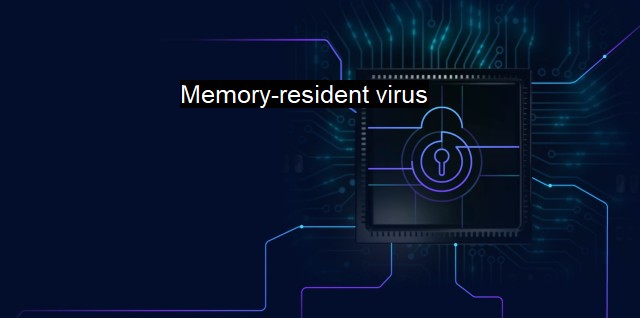What are Memory-resident virus?
Combatting Cyber Threats: Understanding the Memory-Resident Virus and its Impact on Network Security
A memory-resident virus, also known as a Terminate and Stay Resident (TSR) virus, is a type of malicious software that resides in a computer's memory space after the program that it has infected has terminated or ended. The concept originated from the old DOS operating systems, where such viruses realm to interfere with the system's operations, thereby affecting its performance and functionality. It's important to note that these viruses don't dissolve or disappear when you close or stop running the infected application. Instead, they continue living in the computer's memory (RAM), where they can initiate various malevolent actions, reproduce, or infect other files or programs.Understanding the execution sequence of a memory-resident virus holds the key to comprehending its procedures. Here is how it works: Upon running the infected program, the virus code is activated. Once activated, the virus transfers control back to the program. it leaves a portion of itself (the viral code) in the computer's memory. It implies that the virus remains 'resident' even after the user closes the initially infected program. Consequently, the virus enjoys adequate freedom to perform its damaging activities and spread without launching any applications.
A memory-resident virus functions slightly differently from immediate action viruses. The latter operate by infecting files as soon as they are opened, requiring the specific infected program to be running for them to act. In contrast, the former remains lodged within the memory, regardless of whether the originally infected application is ongoing or not.
Dealing with a memory-resident virus presents a formidable challenge due to its nature. Threat actors orchestrate this type of infection to bypass antivirus scans. Since this viral program hides in the groundwork of the system's memory, it escapes being detected and removed by an antivirus program that operates by scrutinizing individual files.
Memory-resident viruses employ different tactics to ensure they remain undetected while conducting their malicious activities. Some of these sophisticated methods include anti-debugging techniques, encryption, polymorphic code, and more, each designed to avoid leaving a similar pattern that could be detected.
These viruses can cause a variety of harm to a computer system. They can alter system settings, format hard drives, corrupt files, slow down processor speed, and create devising security holes whereby other infections can infiltrate the system. these stubborn viruses can carry other payloads like spyware or worms. Cybercriminals often leverage these types of viruses to steal sensitive data, compromise private networks, and execute other illegal actions.
a memory-resident virus represents a significant cybersecurity threat due to its ability to stay concealed. Therefore, regular updating of antivirus software is crucial to cater to the quickly evolving techniques used by such viruses. More advanced technologies such as behavior-based detection systems can enhance the chances of identifying these viruses, offering a solid line of defense. Being proactive in patching system vulnerabilities can also prevent this type of thread. Cybersecurity education, which includes training computer users to refrain from opening suspicious emails or visiting risky websites, remains one of the most effective methods of preventing infections from memory-resident viruses.

Memory-resident virus FAQs
What is a memory-resident virus in cybersecurity?
A memory-resident virus is a type of computer virus that loads itself into memory and remains there, actively infecting and compromising the host computer's operation.How does a memory-resident virus infect a computer?
A memory-resident virus typically infects a computer through an infected file or program. Once the file is opened or the program is loaded, the virus is activated and moves into the computer's memory, where it can continue to replicate and spread to other files and programs.What are the dangers of a memory-resident virus?
The dangers of a memory-resident virus include the potential for significant damage to the infected computer's operation and security. These viruses can compromise sensitive data, slow down or crash computer systems, and potentially spread to other computers on the same network.How can I protect my computer from a memory-resident virus?
There are several steps you can take to protect your computer from a memory-resident virus, including installing and regularly updating antivirus software, avoiding downloading and opening unknown files or attachments, and keeping your operating system and applications up to date with the latest security patches.| | A | | | B | | | C | | | D | | | E | | | F | | | G | | | H | | | I | | | J | | | K | | | L | | | M | |
| | N | | | O | | | P | | | Q | | | R | | | S | | | T | | | U | | | V | | | W | | | X | | | Y | | | Z | |
| | 1 | | | 2 | | | 3 | | | 4 | | | 7 | | | 8 | | |||||||